Mastering Positional Play in Football Manager 2024
Developing tactics and recreating the styles of football’s leading coaches is one of the most enjoyable aspects of playing Football Manager.
In Football Manager 2024, you have more creative tools for expressing your tactical philosophy thanks to the player rotation changes that have been added..
These rotations see players take up a different position while in possession than they occupy while defending, such as an Inverted Full-Back tucking in as an additional central defender or Central Midfielders pushing forward to join the attack.
Making the most of these rotations will allow you to implement positional play principles in your tactics and become a more dynamic attacking team in every career. In this blog, Dan Gear explains which roles trigger these positional rotations and shows them in action.
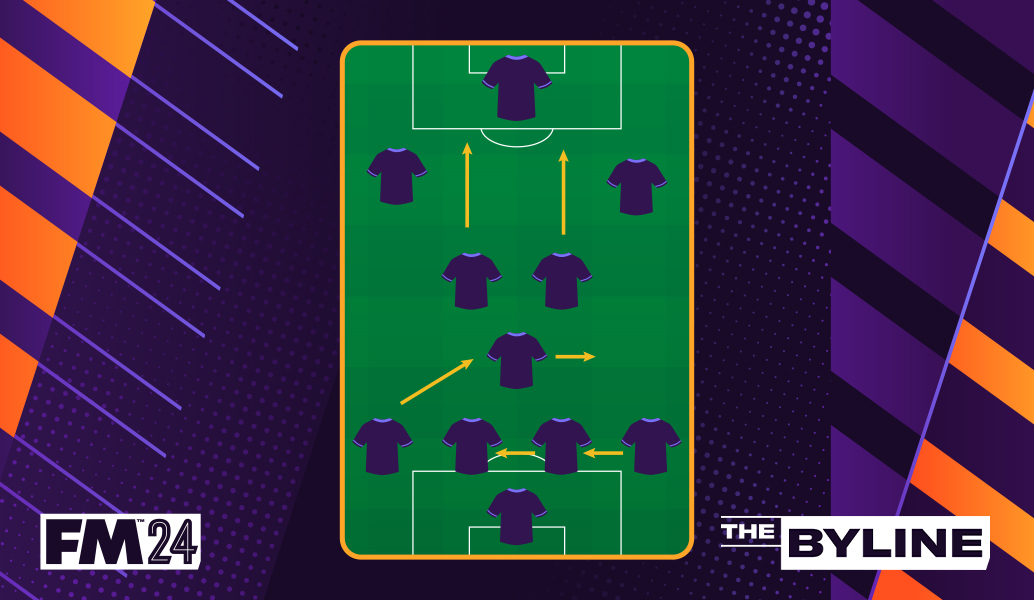
Which roles trigger positional rotations?
Positional rotations are largely reserved for your central midfield players, but there are also a few defensive roles that are crucial for pursuing positional play. These are:
Defenders
- Inverted Wing-Back - During the possession phase, a player using this role will move into defensive midfield
- Inverted Full-Back – A new role for FM24, this is geared towards those players that tuck in to become an extra central defender while in possession
- Libero – Following some upgrades for FM24, a Libero can now play in any of the three centre-back positions, and in each one they will look to move into defensive midfield
Midfielders
• Half-Back – Now usable in both single and double midfield pivots, a player in this role will look to drop back into central defence while you’re in possession
• Segundo Volante – An aggressive role, players deployed as Segundo Volantes will push right up as an extra ‘Number 10’ just behind the strikers when your team is attacking
• Roaming Playmaker – Whether they’re used in defensive or central midfield, Roaming Playmakers will push up to become attacking midfielders during the possession phase
• Box to Box Midfielder/Mezzala/Advanced Playmaker – All of these roles will look to push up from a starting position in central midfield to one just behind the strikers. The same is also true for Central Midfielders used on an Attack duty
Taking a closer look at positional shifting
Now, you might be thinking that if all of your central midfield players push up, you’ll have a lot of overcrowding in the same area of the pitch.
Well, the players in FM24 are intelligent and aware of the movement of their teammates, meaning that this doesn’t happen.
To illustrate this with an example, let’s say you’re using a 4-2-3-1 formation and you’ve chosen to make one of your midfield pairing a Mezzala.
As the image below shows, the originally central Advanced Playmaker will acknowledge the Mezzala’s forward runs and will shuffle across to the left to accommodate them.
In this instance, your wide player will now stay closer to the touchline in order to accommodate the forward runs of the Mezzala, effectively making your formation a 4-1-4-1.
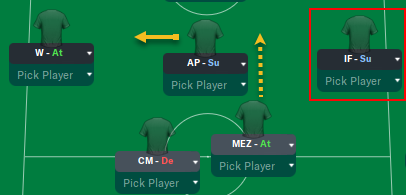
Alternatively, let’s say you chose to play a 4-2-3-1 with a Segundo Volante on the left and a Ball-Winning Midfieder on the right.
Here, the Segundo Volante will push up and on this occasion the player behind the striker will move to the right to once again create a strong 4-1-4-1 shape.
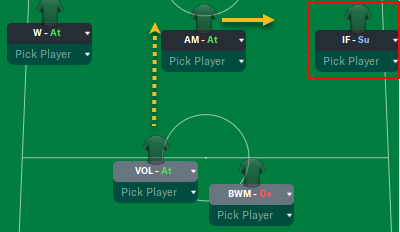
Combining Attacking and Defensive Player Movement
The same is true when you make use of the defensive player roles that shift their position during the attacking phase.
In the example below, we’re playing a 4-3-3 with an Inverted Wing-Back on the left of the defence. In this instance, the Defensive Midfielder will move across to the right to form a double pivot with the Inverted Wing-Back that pushes up.
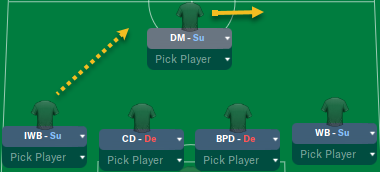
Now, if you pull it all together in a wider tactical shape, you’ll see that your team’s starting formation will look quite different as your players look to progress possession up the pitch.
As the arrows on the screen below show, you’ll effectively have a 3-2-4-1 shape when you’re attacking. This opens up more passing lanes and gives you a greater ability to play through the lines, which in turn means you’re going to be much more effective in exploiting gaps in the opposition defence when you’re counter-attacking.
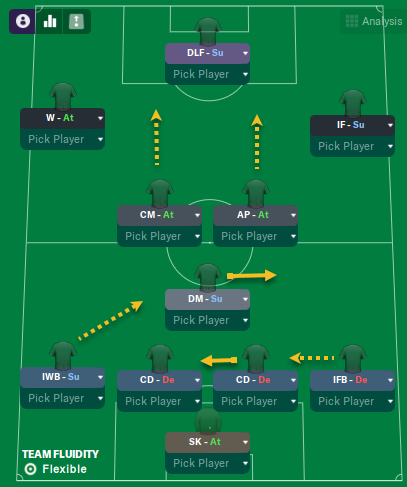
Putting Positional Play into practice
Now we’ve gone through the theory, let’s see how we can implement these player rotations and positional play principles in practice with a real team and tactic. Here, I’ve chosen to use Italian club Bologna.
In this first scenario, I’ve opted for a fairly simple 3-4-3 tactic. The formation makes the most of some of our most talented players, namely Victor Kristiansen, central defender Riccardo Calafiori and clinical striker Joshua Zirkzee.
I’ve kept it on a Balanced Mentality as the player roles chosen are attacking enough on their own, while I’ve only selected a few simple Team Instructions as I want the players to focus on their natural games and moving around the pitch in the way the roles intend them to.
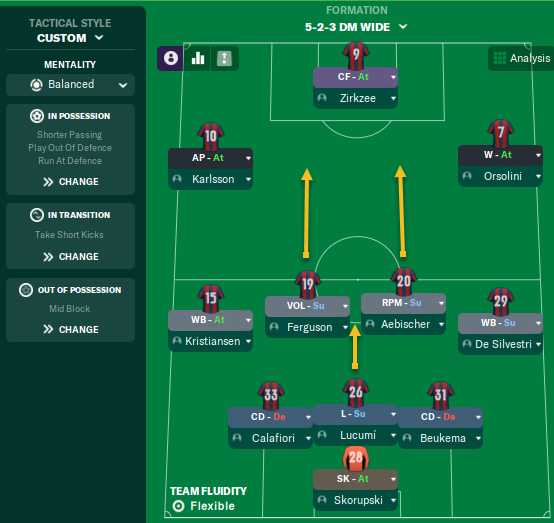
As you can see from the screenshot below, Lewis Ferguson, Michael Aebischer and Jhon Lucumí all rotate into more advanced positions when we’re attacking the opposition.
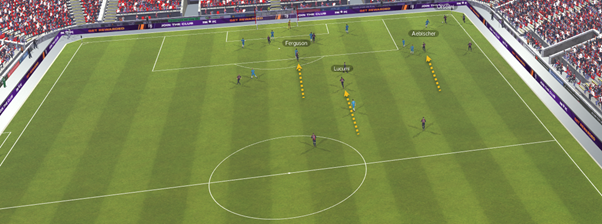
In that instance we failed to score. When play restarted and the opposition were looking to progress possession, they all moved back into their starting positions to give us better defensive cover.
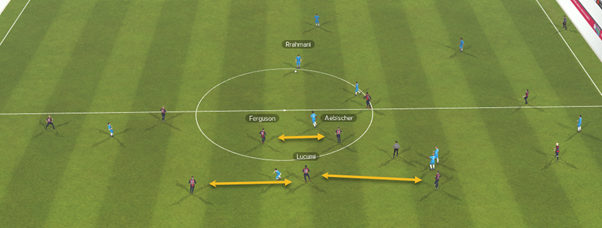
In the second example, I’ve used a 4-2-3-1 similar to the one outlined earlier on. From what we know of the positional rotations, the shape I’ve picked should see Aebischer push up and join Ferguson as a second attacking midfielder in a four-man unit behind Zirkzee.
Further back, Calafiori is playing as an Inverted Full-Back, meaning that he’ll push across and Lucumí and Sam Beukema will adapt accordingly to form a back three.
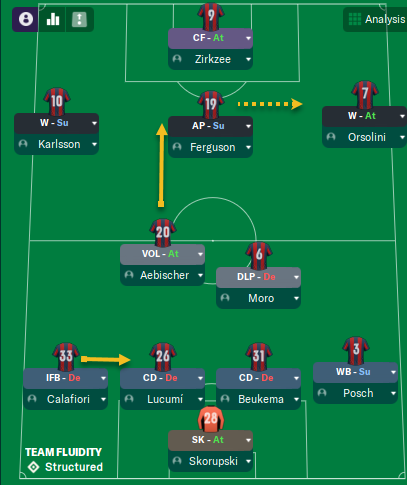
In terms of Mentality and Team Instructions, everything reflects the first example as all rotations and shifts are automatic. You don’t need to add any extra player or team instructions, you only need to understand which roles rotate into which areas and how you can make space for them in your tactic.
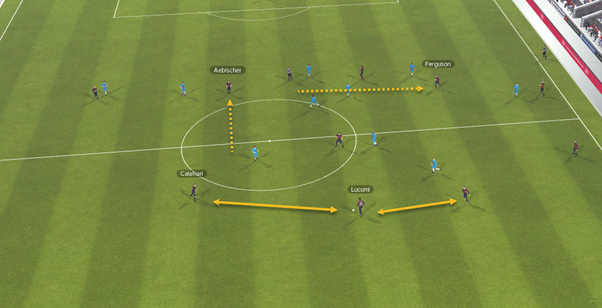
To take the previous example a bit further, you could make Stefan Posch an Inverted Wing-Back rather than a Wing-Back. You’ve got enough ability in the wide areas with Riccardo Orsolini and Jesper Karlsson, so you can instead use Posch in a capacity that makes him an extra ball receiver in midfield and more effective defensive cover should you lose possession.
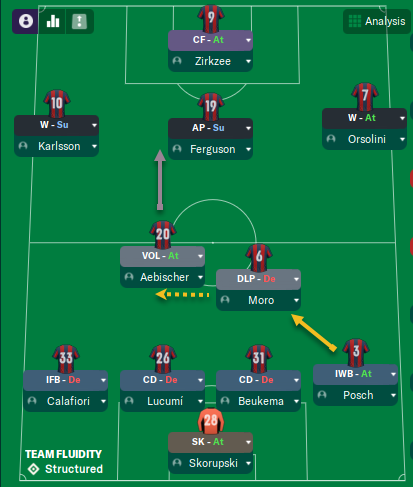
As you can see from the screenshot below, Posch has moved up and across to form a defensive midfielder pivot with Nikola Moro, who has moved across into the space that Aebischer has vacated by pushing up.
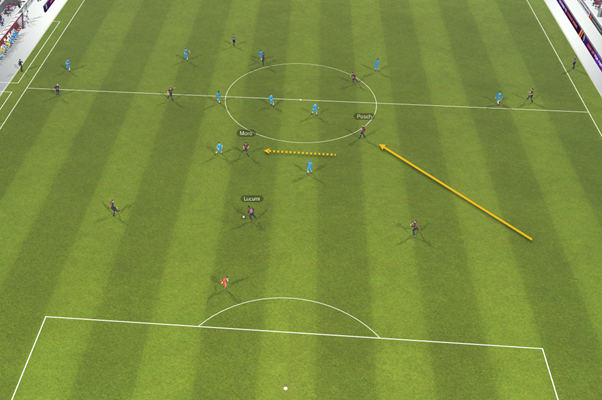
Hopefully the information provided here will have given you a greater insight into how FM24’s positional rotations work in practice and how you can make the most of them to build more fluid tactics in FM24.
Happy managing,
Dan Gear
















